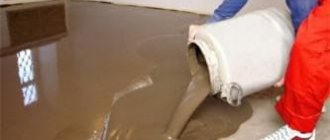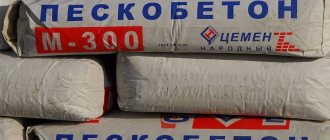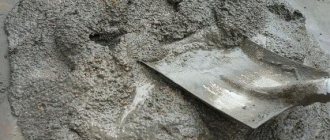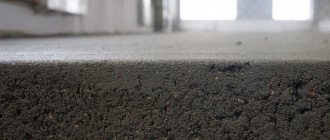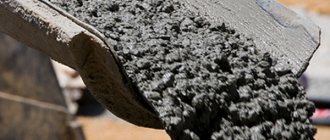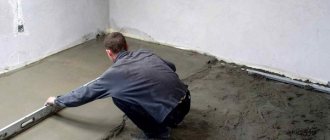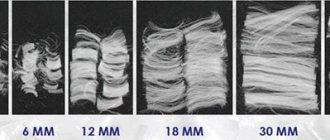When building a house, it becomes necessary to use a material such as a cement-sand mixture. Thanks to this combination of ingredients, it is possible to obtain a reliable coating for the wall, make a strong floor screed, or even lay a brick wall. You can purchase this composition in a ready-made form in the store or prepare it yourself. If you choose the second option, then it is considered the most economical; in addition, you yourself will be able to regulate the concentration of the flow of your mixture.
Count your expenses. All rates and costs are below:
How many cubes in a bag of dry cement or building mixture:
2. Cement-sand mortar for masonry:
For 1 m2 of brickwork with a masonry thickness of 1 brick, the amount of mortar approaches 75 liters of consumption per 1 m2. If the wall is made of brick with a thickness of 1.5 bricks, then the amount of mortar will correspond to the figure of 115 liters.
3. Proportions of cement mortar:
In order to prepare a mortar, you need: 1 part of a binder (cement) and 4 parts of filler.
4. Proportions of plaster mixture:
You will need 1 part binder (cement) and 3 parts aggregate.
5. Cement mortar for brick:
According to consumption standards, 400 pcs. bricks (more precisely 404) - 1 m3 of masonry. The solution consumption rate per 1 m3 is 0.23 m3 (in practice, 0.25 is accepted).
6. How to calculate the consumption of sand concrete M - 300 per screed?
The approximate density of the sand concrete mixture is 1.7-1.75 kg/cubic dm
For 1m/2 with a thickness of 1cm = 18-20 kg of mixture (sand concrete M300).
The consumption of tile adhesive per 1 m2 of laid tiles is 10 kg. dry mixture with a layer thickness of the finished solution of 10 mm.
8. Adhesive for foam concrete blocks and gas silicate blocks:
The consumption of foam concrete adhesive per 1 m3 of laid foam concrete masonry is 40 kg. dry mixture
9. Self-leveling floors:
The consumption of self-leveling floors per 1 m2 of finished mortar is 6 kg. dry mixture, with a recommended layer thickness of 5 mm.
10. Plasters for walls:
The plaster consumption per 1 m2 of finished mortar is 10 kg. dry mixture, with a recommended layer thickness of 10 mm.
11. Wall putties:
The putty consumption per 1 m2 of finished solution is 0.9-1.0 kg. mixtures.
12. Grout (tile joints):
The grout consumption per 1 m2 of laid tiles is 120 g, with a recommended joint thickness of 2 mm.
13. Universal mixture M −150:
The consumption of the universal mixture M-150 per 1 m3 of the finished solution is 450 kg. dry mixture.
14. Masonry mixture M-200:
The consumption of the M-200 masonry mixture per 1 m3 of masonry is 350 kg. dry masonry mixture.
15. Waterproofing material (penetrating layer):
Waterproofing consumption per 1 m2 of surface will require 700 g. dry mixture diluted to a sludge state for application with a brush (roller).
Paint consumption per 1 m2 of walls or ceilings when first applied to a primed, flat surface is 0.3 liters, the second layer when applied correctly is 0.2 liters per 1 m2.
17. Polyurethane floors:
The consumption of polyurethane self-leveling floor when applied to a dust-removing primer is 1.5 kg per 1 m2 of concrete floor surface, with a thickness of 1 mm.
Amount of cement per masonry (cement consumption per bricklaying):
To prepare 1 m3 of cement mortar you need 8 50 kg bags of cement. and mixed with sand in a ratio of 1:4, where one part of sand is also equal to 50 kg.
19. The consumption of materials (excluding losses) for the construction of 1 m2 of the surface of a brick wall with a thickness of a quarter of a brick is:
cement (for mortar grade M-100) - 5 kg;
cement (for mortar grade M-75) - 4 kg;
cement (for mortar grade M-50) - 2.5 kg.
How much cement, sand, crushed stone in 1 m3 of concrete (how to prepare concrete - proportions):
a) For 1m3 M 150 concrete you will need: 220 kg of cement, 0.6 m3 of sand, 0.8 m3 of crushed stone.
b) For 1m3 M 200 concrete you will need: 280 kg of cement, 0.5 m3 of sand, 0.8 m3 of crushed stone.
c) For 1m3 M 250 concrete you will need: 330 kg of cement, 0.5 m3 of sand, 0.8 m3 of crushed stone.
d) For 1m3 M 300 concrete you will need: 380 kg of cement, 0.5 m3 of sand, 0.8 m3 of crushed stone.
21. Clay-sand mortar. How to cook:
Clay-sand mortar is a 1:3 proportion, where one part clay mortar and three parts vermiculite. The resulting solution is poured in a layer up to 50 mm
To make the clay-sand mortar layer for a warm screed or wall construction even warmer, you need to mix the clay-sand mortar in a 1:1 ratio with sawdust or flooring (finely chopped straw). The prepared solution is poured into a layer 20-30 cm thick.
22. Proportion of concrete and foam chips:
In order to create such a solution, which is mainly used for insulating floors and ceilings of bathhouses, you need to mix 1 part of ordinary cement mortar (or ready-made concrete mortar) and 3 parts of foam chips.
23. How many blocks are there in 1 m3 of masonry?
Size 200×300×600 – 27 blocks per 1m3
Size 200(188)x200(188)x400 - 62 blocks per 1 m3
24. Secrets of brick or block facing masonry, masonry mortar + black seam:
Consumption - 1-1.5 buckets of solution per 1m2. Instead of an expensive plasticizer, 2 caps of cheap shampoo (for plasticity) per batch of 1/4, 1 liter. a jar of black pigment, and in order to avoid efflorescence, 200g. 9% vinegar solution.
25. Penetrating waterproofing penecrit and penetron:
Penecrete 150-200 grams per seam 25×25 mm per 1 linear meter of grooves
Penetron (for 2 layers according to technology) from 0.8 kg - 1.1 kg per 1 m2 depending on the looseness and unevenness of the surface
How many bricks are needed for 1m2 of masonry:
a) If the wall thickness is half a brick - 120 mm
b) If the wall thickness is one brick - 250 mm
c) If the wall thickness is one and a half bricks - 380 mm
d) If the wall thickness is two bricks - 510 mm
e) If the wall thickness is two and a half bricks - 640 mm
How many facing bricks in 1m2
Any construction project is an expense, and not a small one, but if you know the rules, you can prevent yourself from being deceived by unscrupulous workers.
Didn't you find something? No information? Write your question below - we will find the answer and send the result to you by email. September 18, 2022 The guideline for the output foam from one cylinder is about 90-110 linear meters, with a seam of about 1-2 cm. Adhesive foam allows you to fix about 10-13 meters of surface,... June 04, 2019. Approximately you will need: Cement 150 kg Sand 450 kg And foam plastic granules of your choice. (In this case, the synthetic material will only affect the insulation factor... June 04, 2022 If the glue per 1 m3 of masonry blocks is about 30 kg with a layer of 2 mm, then approximately the consumption of DSP with a thickness of about 5 mm (because it is difficult to catch the exact... March 25, 2022 g. For the construction of 1 m2 of the surface of a brick wall with a thickness of a quarter of a brick is: cement (for mortar grade M-150) - 5 kg; sand for... March 18, 2022 0.010 cubic meters in a 25 kg sand concrete bag in a pipe with a diameter of 100 mm and a length of 1 mm "
How much does 1 cube of dry mixture weigh, the weight of 1 m3 of dry mixture. The number of kilograms in 1 cubic meter, the number of tons in 1 cubic meter, kg in 1 m3. Bulk density of dry mixture specific gravity.
Table 1. How much does 1 cube of dry mixture weigh, the weight of 1 m3 of dry mixture. Bulk density and specific gravity in g/cm3. How many kilograms are in a cube, tons in 1 cubic meter, kg in 1 cubic meter, tons in 1 m3.
Source
Briefly about sand concrete
The composition of sand concrete consists of the following components:
Carrying out calculations
Construction mixtures are packaged in sealed bags, weight varies from 25 to 50 kg. Therefore, when drawing up cost estimates, you should decide how many bags of sand concrete are needed per 1 cubic meter of finished mortar. If we talk about the volume of one unit of popular mixtures per cubic meter. m, then it looks like this:
The specified data will help you find the consumption of CPS per 1 m3 of finished solution
Using ready-made formulas, we calculate the number of packages using the following algorithm:
The working solution is prepared by mixing a variety of components. Let's consider the consumption of the working solution of the mixture and water for popular brands. So, for M100 you will need 550-570 kg per cubic meter, M150 - 570-590, M200 - 590-620, M300: 620-660, M400: 660-710.
In addition to the density of the CPS, it is important to take into account the mass fraction of cement and the sand fraction. After all, the higher they are, the greater the weight of 1 cubic meter of solution. Regarding consumption, the parameters of the planned monolith must be taken into account.
Convert kg of concrete solution to cubes (m3)
');> //—> Reference data: Density of concrete solution = 500 ... 2500 kg/m3 Density of concrete solution in this calculation = 2400 kg/m3 If you need to convert m3 to kg for any material with any density, then see the universal calculator to convert m3 to kg. The density of the concrete solution tends to change depending on the temperature and pressure of the environment. See reference books for exact density data. Theory: The relationship between volume and mass is determined by a simple mathematical formula: V = m / p, where V is volume; m—mass; p—density. Solutions: You can quickly solve this simple mathematical operation using our online program. To do this, enter the initial value in the appropriate field and click the button.
This page provides the simplest online converter of units of measurement for cubic meters of concrete mortar to kg. With this calculator you can convert kg of concrete solution to m3 and vice versa in one click.
Compositions of building materials
The ratio of sand and cement in different mixtures.
The bulk density of cement is 1300 kg/m3, and the sand fraction of 0.8-2.0 mm is 1500 kg/m3.
Calculating the bulk density of the finished material is quite simple:
When making calculations, it is necessary to take into account that the higher the density of the material, the smaller the volume. To determine the volume of a bag of sand concrete, it is necessary to divide the mass of the bag by its density.
Volume of sand concrete bag and number of packages in 1 cube
| Type of cement | 50 kg | 40 kg | 25 kg |
| M-150 | 29 bags | 36.25 bags | 58 bags |
| M-200 | 30.24 bags | 37.8 bags | 60.48 bags |
| M-300 | 28.5 bags | 35.7 bags | 57.12 bags |
A regular 12 liter bucket can hold:
Interaction with sand concrete is quite difficult, so knowing certain nuances will significantly simplify this process.
You can buy sand concrete in our store - we will help you calculate the amount of mixture required and the total volume of cargo.
Source
Calculation of how much mixture is needed per 1 m3
Intuitively, every person should understand that the consumption of the presented mixture will depend on the strength of the structure that will be erected. For example, to build a foundation you need M300 concrete and no lower, but for a screed, a solution with a strength of 150 kg/cm2 is quite suitable. Each brand of mixture has its own properties and scope of application.
The higher it is, the less material is needed. Knowing the consumption of the mixture per meter cubed is very important, because in this way you can purchase the exact amount of material and not worry that you will need to bribe it. In addition, when purchasing, you can even purchase material in a larger volume, since its consumption is greatly influenced by the type of structure being built. It will also be interesting to read about how many bricks are in 1 m3 of masonry.
Plastering walls
When performing such work, a classic plaster mortar is most often used. It contains components such as sand, cement, taken in a ratio of 1:3.
When leveling the surface, material consumption will be directly related to the thickness of the applied layer. If this parameter does not exceed 12 mm, then for 1 m3 of plaster you will need to stock up on 1.6 kg of M40 mixture or 1.4 kg of M500 mixture. The volume of solution per m2 is easy to calculate. To do this, we use the above formula: 1m2x0.012 m = 0.012 m2 or 12 liters.
Find out the difference between the brand and the class of concrete.
Here you can see photos of the base panels.
Approximate prices for expanded clay concrete blocks: .
